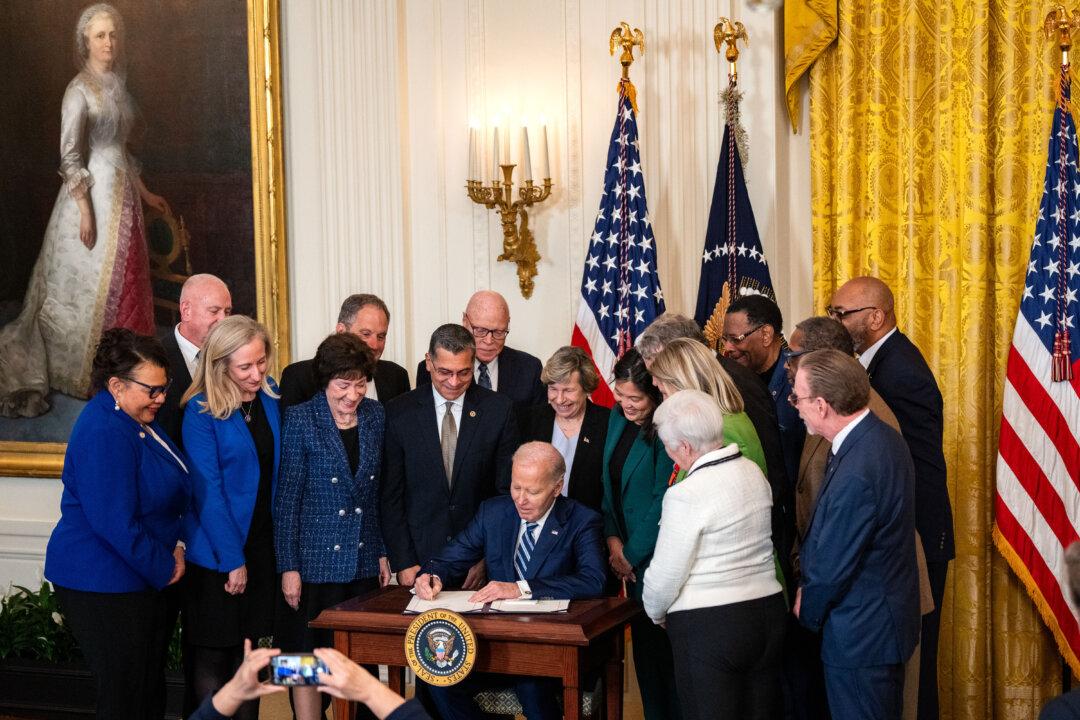In its report on the Jan. 6, 2021, Capitol breach, the House Jan. 6 panel made a series of contested claims about the events of that day and the weeks leading up to it while excluding details of several key events leading up to the rally.
The report is the culmination of a months-long investigation by the panel, which is dominated by critics of President Donald Trump. Only two Republicans, outgoing Ranking Member Liz Cheney (R-Wyo.) and Rep. Adam Kinzinger (R-Ill.) sit on the committee. Both have been vocal critics of the former president.
The report repeats many of the claims that have already been repeated ad infinitum by the panel and its allies.
Ed Martin, a top attorney for Jan. 6 defendants, told The Epoch Times in a phone call that the narrative pushed by the committee should be taken with a great deal of scrutiny.
“It’s a political argument, that they’re making not a legal argument and when they stray into legalese they’re really misleading the public,” Martin ruled.
He also noted the lack of truly adversarial voices on the committee, a critique with its roots in the way that the committee was set up and the way its members were selected.
“This was not passed through the house,” Martin said. “This was created out of nothing by Pelosi.”
Across the rest of U.S. history, such committees have been established on a bipartisan basis, with the leaders of each party selecting their membership on the panel. However, when Speaker of the House Nancy Pelosi (D-Calif.) established the committee, she refused House Minority Leader Kevin McCarthy’s (R-Calif.) picks for the panel, Reps. Jim Banks (R-Ind.) and Jim Jordan (R-Ohio); instead, Pelosi tagged Cheney for the top GOP spot and Kinzinger for the other position.

This refusal to accept McCarthy’s appointees was unprecedented in the history of Congress. Critics have said that it crippled the select committee’s true investigative power from the beginning by taking away any adversarial voices on the panel.
The process to form the committee, Martin added, “was so obviously political.
Committee Narrative Legally Tenuous
According to the committee’s narrative of the events on and leading up to Jan. 6, the events of Jan. 6 were the climax of weeks of effort by Trump and his allies to overturn the results of the 2020 election. However, many of its claims in the summary of the report are legally tenuous according to critics of the panel.Though nobody has been so much as charged with insurrection, members of the panel have on a plethora of occasions referred to the events of that day as an “insurrection.”
In their report, the Jan. 6 panel says that the events and claims that would culminate in the Capitol breach began as early as election night.
“Beginning election night and continuing through January 6th and thereafter, Donald Trump purposely disseminated false allegations of fraud related to the 2020 Presidential election in order to aid his effort to overturn the election and for purposes of soliciting contributions,” the committee writes. “These false claims provoked his supporters to violence on January 6th.”
This section continues a long-running trend by the panel of blaming Trump’s claims for the violence that would break out on Jan. 6. However, the panel has struggled to prove that there is more than a correlational link between what Trump said and what his supporters did.
“You can’t be held accountable under the law, liable under the law, either criminally or civilly, for something someone else does, absent specific criteria,” Martin noted, contesting the notion that the Jan. 6 panel had effectively proven a link between Trump’s claims about the 2020 election and the Capitol breach.
In fact, Martin noted, the record shows that Trump’s public comments were critical of the violence.
“Well, wait, Donald Trump actually did a video and said, you know, go home be peaceful. He did tweets that said, respect our cops,” Martin said, citing several tweets and videos released by Trump on Jan. 6. “If you push [Democrats on this point], their answer will be ‘He didn’t mean it.’ They’re mind reading. He didn’t do it fast enough. Well, there’s no standard on fast enough of a riot at the Capitol like that’s not a thing to make a serious argument about. So you’re sort of … again, you’re into a political argument pretty quickly.”
The committee narrative continued by placing blame on Trump for “[refusing] to accept the lawful result of the 2020 election.”
“Rather than honor his constitutional obligation to ‘take Care that the Laws be faithfully executed,’” the panel wrote, “President Trump instead plotted to overturn the election outcome.”
The panel further argued that “[d]espite knowing that such an action would be illegal, and that no State had or would submit an altered electoral slate, Donald Trump corruptly pressured Vice President Mike Pence to refuse to count electoral votes during Congress’s joint session on January 6th.”
Trump and his allies, documents and testimony show, sought to push Pence to refuse to certify electoral slates from states accused of election fraud.
However, the claim that this approach was inherently illegal remains contested due to ambiguities in the way that current federal election law is structured.
The committee narrative continues, “Based on false allegations that the election was stolen, Donald Trump summoned tens of thousands of supporters to Washington for January 6th. Although these supporters were angry and some were armed, Donald Trump instructed them to march to the Capitol on January 6th to ‘take back’ their country.”
Again, however, the circumstantial link between Trump’s claims of election fraud and the outbreak of violence at the Capitol remains tenuous at best, despite the panel’s efforts to link the two.
Pipe Bombs Absent From Report
Shockingly, the report makes no mention of pipe bombs that were planted at the Democratic National Committee (DNC) and Republican National Committee (RNC) headquarters on Jan. 5, 2021.The unknown bomber, who was captured planting the bombs in Jan. 5 surveillance footage, has not been identified.

The bombs were planted in front of the DNC and RNC buildings.
Then-Vice President-Elect Kamala Harris was even in the DNC building at the time. But curiously, this fact was left out of the Jan. 6 panel’s narrative, though the bombs were planted within a few dozen yards of the Capitol building.
Martin opined that this is one of the most baffling oversights from the committee.
“The panel says things like, ‘Oh, it was an armed insurrection,’ and you’re not looking at the pipe bombs that were within a few 100 yards of the Capitol complex,” Martin said. “What are you doing? Because again, if someone had a bazooka in their car three blocks away, I would think you’d be saying, ‘Hey, let’s talk about it.’”
National Guard
At one point in the report, the panel condemns Trump for failing to call in the National Guard.“President Trump had authority and responsibility to direct deployment of the National Guard in the District of Columbia, but never gave any order to deploy the National Guard on January 6th or on any other day,” the panel report says, portraying this as a dereliction of duty on the president’s part.
However, carefully evaded by the report is the similar role played by Pelosi’s appointees in the lead-up to the Jan. 6 rally.
On several occasions before the Jan. 6 rally, former U.S. Capitol Police Chief Steven Sund requested that the National Guard be brought in. These requests were on several occasions denied by Pelosi’s appointed House Sergeant at Arms.

Sund was forced to resign from his post after the Capitol breach.
The committee report scarcely mentions Sund’s requests or Pelosi’s refusals. Where the report does mention it, the report dismisses the importance of Sund’s request.
“Although Chief Steven Sund raised the idea of National Guard support, the Capitol Police Board did not request Guard assistance prior to January 6th,” the panel wrote.
“This partisan sham committee is not focused on answering the most important questions of why the Capitol was left unprepared that day and how we can ensure this never happens again,” argued Rep. Elise Stefanik (R-N.Y.) during a conference call on Jan. 6, 2022. “The American people deserve to know what the mainstream media refuses to cover: The fact that the only office that is off-limits to this partisan sham investigation is Speaker Pelosi’s office.”
Stefanik’s comments are not hyperbole—Jan. 6 Committee Chairman Bennie Thompson (D-Miss.) gave explicit direction that Pelosi was off limits to the committee’s investigations.
Rep. Troy Nehls (R-Texas) indicated in comments to The Epoch Times that he places the blame squarely on Pelosi, who he said refused to prepare the Capitol in order to harm Trump’s political prospects.
“I think Nancy Pelosi could have prevented all this,” Nehls said. “They could have prevented it but they chose not to. And now what they’re doing with this January 6 committee, they’re using it to try to keep Donald Trump off the ballot in 2024.”
Nehls then reported his conversations with Capitol Police officers since that day. These conversations, Nehls said, have made clear to him that the officers had no clue what to expect that day.
“I’ve talked to the Capitol Police,” Nehls said. “There’s a lot of great men and women that make up that organization—1,840 strong.
“A lot of men and women have a lot of concerns about the leadership of the Capitol police,” Nehls continued. “These 1,840 personnel—they had really no clue what was going to happen that day. None of the intelligence was shared with the men and women working that day—they were taken by surprise.
Oath Keepers
“The intelligence community and law enforcement agencies did successfully detect the planning for potential violence on January 6th, including planning specifically by the Proud Boys and Oath Keeper militia groups who ultimately led the attack on the Capitol,” January 6 Committee report reads.However, during the Oath Keepers’ eight-week trial, no proof was shown that the group led the attack on the Capitol on January 6, 2021. Stewart Rhodes, the Oath Keepers’ leader, as well as three other Oath Keeper members and one affiliate, were on trial at the same time. Some of them did not even meet before the trial date.

Rhodes did not enter the Capitol building on Jan. 6. Neither did the affiliate, Thomas Caldwell. Only Jessica Watkins, Kenneth Harrelson, and Kelly Meggs did. Rhodes and Meggs were charged with seditious conspiracy, the other three were acquitted of that charge, but convicted on other Jan. 6 counts.
During the weeks-long trial, none of the 50 witnesses said they witnessed any premeditated plan to overthrow the government on Jan. 6. No FBI agent either found a clear, detailed plan that showed how the Oath Keepers planned to attack the Capitol.
An implicit agreement and mutual understanding were enough to prove the defendants’ conspiracy, he said.
Moreover, multiple video exhibits have shown that the first people who entered the Capitol doors were not Oath Keepers. The Oath Keepers, who entered the Capitol, were not seen on the front lines.
Some of them said they were pushed by the crowd and swept in.
“It was really stupid. I got swept up … I realize it was wrong,” said Jessica Watkins, an Oath Keeper from Hilliard, Ohio, during her testimony. Watkins told the court she entered the Capitol on a whim, comparing it to a Black Friday crowd.
Rhodes testified on Dec. 19 in an Alaska civil trial that the Oath Keepers never planned to disrupt or delay the joint session of Congress’s certification of Electoral College votes on Jan. 6.
The January 6 committee report also doesn’t mention that Rhodes sent two open letters asking Trump to invoke the Insurrection Act. Rhodes and other Oath Keepers brought long rifles, pistols, and other types of ammunition to a hotel in Virginia. However, on January 6, no Oath Keeper took any of these weapons into the district.
The Oath Keepers argued that bringing the rifles to Virginia in case Trump invoked the Insurrection Act due to attacks by Antifa or other left-wing groups. Trump did not call for the Insurrection Act, and thus none of the ammunition deposited at the hotel in Virginia was ever used on that day.
One of the government witnesses, Terry Cummings, 66, who served for 21 years in various classified locations for the Air National Guard, said that the Oath Keepers were present on Jan. 6, 2021, in case innocent people were hurt and the police wouldn’t intervene. Cummings has not been charged with any count related to January 6.
Throughout 2020, Antifa and other groups caused damage to small businesses and public property in cities across the country.
In 2020, Cummings joined Oath Keepers in Florida. He worried about Antifa and Black Lives Matter protests in Oregon, where he was born. Portland was beautiful and safe; had festivals until the Antifa protests began.
‘Despicable’ Conditions
Absent from the report was any mention of the conditions faced by Jan. 6 defendants, who have experienced violations of a slew of their legal rights and protections, facing conditions that one critic has described as “despicable.”Greene relayed reports that Jan. 6 defendants held in the D.C. Metropolitan Jail have been beaten by guards and prison staff, have been unable to speak with their attorneys, have been denied haircuts or razors to shave, and have not been given proper medical treatment when they needed it, among many other examples.

Greene noted another peculiarity of the Jan. 6 defendants: Usually, Greene says, members of Congress have no problem in gaining access to jails when they make the request. In this case, however, Deputy Warden Kathleen Landerkin denied Greene and her coalition access to the facilities on several occasions before finally allowing access to the representatives.
“In fact, [Landerkin] locked us out before,” said Greene, adding, “It’s clear that there was a lot to hide.”
“What’s happening to these people being held in custody is wrong, it’s unconstitutional, it’s a violation of their rights, and it is an abuse that I call on every member of Congress to pay attention to,” Greene said.
The District of Columbia jail, Greene said, has been known as “a despicable place” since the 1970s, and she noted a decision from a U.S. District Judge who ruled that the prevailing conditions in the jail violate the 8th Amendment ban on cruel and unusual punishment.
Little has changed since this decision, Greene said, citing a 2015 report that found that the jail was “plagued by mold, vermin, and water leaks.” More recently, Greene added, the U.S. Marshall Service in 2021 found the jail to be “inhospitable.”
Despite the well-documented problems with the building, the Jan. 6 defendants have been forced to reside in the jail for months on end.
“But the January 6 defendants are being treated differently on a whole other level,” Greene said. “They have been beaten by the guards, they are called ‘white supremacists,’ they are denied religious services, haircuts, shaving, the ability to trim their fingernails.”
Greene continued, “They’re denied time with their attorney, they are denied the ability to even see their families and have their families visit there, they’re denied bail and are being held there without bail.”
“Many of these people have never been charged with a crime before,” Greene said. “Some of them are veterans.”
Aside from all these alleged violations of their liberty, Greene reported, the defendants “have been told that they have to denounce President Donald Trump” and “that their views are the views of cult members.”
In sum, Greene ruled, the Jan. 6 defendants have been treated “worse than we treat terrorists in [Guantanamo Bay].”
Other stories have circulated describing a horrendous sexual assault against a military veteran who was arrested in connection to Jan. 6, among many others.
Unsurprisingly, the committee report makes no mention of the plight of these defendants, who even many Republicans have shied away from defending.






